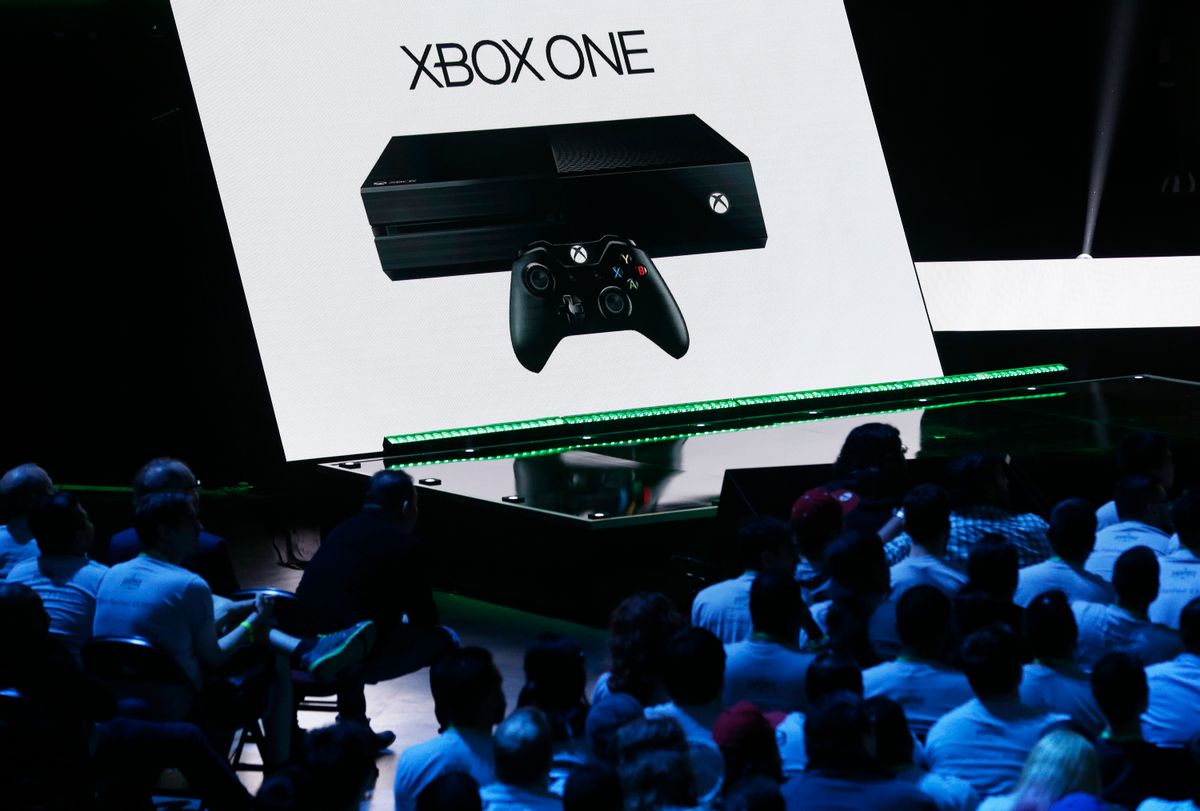By 2030, Microsoft has pledged to become "carbon negative" — meaning it will remove more carbon from the air than it emits. To do so, the U.S. tech giant announced this month that it will slash annual emissions not only from its offices, factories, and data centers but also from the living rooms and basement dens where people use its products. That means tackling the outsized impact of a relatively small device: the Xbox.
The gaming console has the largest carbon footprint of any Microsoft device, due to the amount of electricity people use while playing video games, a company spokesperson said by email. Each Xbox One X console, for instance, contributes the equivalent of more than 1 ton of carbon emissions over eight years — and 86 percent of that is solely from product use. (The remaining 14 percent is from manufacturing, packaging, shipping, and end-of-life recycling.)
We don't tend to think of video gaming systems like refrigerators, air conditioners, or water heaters — common appliances that gobble electricity if not designed or used efficiently. But collectively, the gaming done on consoles, PCs, and mobile devices has a big impact. In the United States, annual emissions from gaming equal that of 85 million refrigerators, or 5 million cars, scientists at Lawrence Berkeley National Laboratory said in a 2019 study.
"Over time, as the technology marches forward, [gaming systems] become more energy-intensive," said Evan Mills, the study's lead author and a research affiliate at the University of California, Berkeley. The 1970s-era game Pong, for instance, used about 10 watts of power on the original Atari console. An Xbox One X uses about 108 watts during gameplay, while high-performing gaming desktops can use nearly 700 watts.
Before its recent climate pledge, Microsoft mainly focused on cutting emissions from day-to-day operations and its global supply chain. Yet most of its footprint falls into a category known as "Scope 3": emissions that stem from indirect activities, such as employees flying for work, or customers typing on Surface computers and battling on Xbox consoles. Of the 16 million metric tons of carbon that Microsoft expects to emit this year, three-fourths are considered Scope 3.
To become carbon negative, the tech firm said that it will shift to using only renewable energy and electric vehicles in its operations, while also investing $1 billion to develop carbon removal technologies. For the Xbox specifically, Microsoft told Grist that it will continue improving consoles' software and hardware components so that they conserve energy, while also working with suppliers to more accurately track the Xbox's footprint and reduce emissions from production and transport.
"We are deep diving into technologies that can reduce power consumption during each usage mode," the company's spokesperson said, referring to the fact that consoles require electricity both during use and during their "sleep" settings.
These efforts will build on a previous Microsoft pilot program to make "carbon neutral" Xbox systems. Last fall, the company bought renewable energy credits and carbon offsets equivalent to 600,000 tons of CO2 — enough to cover the lifecycle emissions of 825,000 gaming consoles. (Microsoft has sold at least 47 million Xbox Ones since the product's launch in November 2017.) However, the company said it's now moving beyond offsetting individual consoles by working to eliminate all devices' indirect emissions.
It's hard to know whether the company's efforts can fully account for gaming-related emissions, given how tricky they are to measure. Microsoft has said that it's "extremely challenging" to determine the typical energy use of a gaming console. The calculation is highly dependent on which types of video games users are playing, and how long they spend playing games or streaming movies.
It doesn't help that video gaming's carbon footprint is a moving target — and one that's not necessarily moving in the right direction.
Even if a gaming system becomes more energy-efficient, the devices' overall power consumption can still climb. As video games become more technically complex and visually realistic, devices also require more processing power, which uses more energy. Monitors, TVs, speakers, and other accessories further boost electricity demand. Cloud-based gaming, an increasingly popular option, puts a greater burden on servers and data centers. On top of that, more people are gaming: about 66 percent of the U.S. population 13 years and older, up from 58 percent in 2013, according to Nielsen.
"Gaming, like video streaming, is this rapidly expanding slice of rising internet data flow — and therefore of energy use associated with the internet," Mills said. (U.K. researchers have estimated that YouTube streaming produced the equivalent of 10 million metric tons of CO2 worldwide in 2016.)
Mills's research team spent two years evaluating 26 different gaming systems from its "green gaming" lab in California. Researchers and participants played 37 popular games — including Call of Duty: Black Ops and FIFA17 — to understand how player behavior and technology components affected the power requirements for desktop computers, laptops, consoles, and media streaming devices.
In the end, they estimated that gaming in the United States uses some $5 billion worth of electricity every year. That's about 2.4 percent of total U.S. residential electricity use. If the grid ran solely on renewables, the climate impact might be negligible. But nearly 63 percent of U.S. electricity generation still comes from coal- and gas-fired power plants.
As gaming draws more scrutiny from researchers, consumers, and the press, tech companies are rolling out initiatives to curb the industry's energy appetite.
In 2015, the world's top console makers — Microsoft, Nintendo, and Sony — signed a voluntary agreement to set maximum power limits and incorporate automatic shutoff functions for consoles sold within the European Union. Last fall, 21 gaming companies formed a partnership with the United Nations and committed to planting trees, purchasing carbon offsets, and adding "green nudges" to remind players to turn off consoles.
Sony, which has sold more than 106 million Playstation 4 consoles, said it would add "low power suspend mode" to its next generation of Playstations. According to Sony, if a million Playstation users enable the low-power feature, it will save enough electricity to equal the average usage of 1,000 U.S. homes.
Mills's research team found that companies can cut gaming's energy use in half just by improving hardware and software and making obvious efficiency tweaks. Some systems, for instance, draw as much energy when idling as when players are actively gaming.
Beyond the box, players themselves have many ways to reduce their gaming-related footprint (aside from the obvious step of gaming less). Choosing energy-efficient TVs and displays will shrink electricity demand, as will shutting off devices when they are not in use. Greening the Beast, a website founded by Mills's son, Nathaniel, offers specific tips for building more energy-efficient desktop PCs, for those who know their way around a motherboard or graphics processing unit.
"Behavior is a big sneaker in the whole energy and climate change area," Evan Mills said. "The human factor in energy use in homes or offices or gaming is just as important as the technology."


Shares